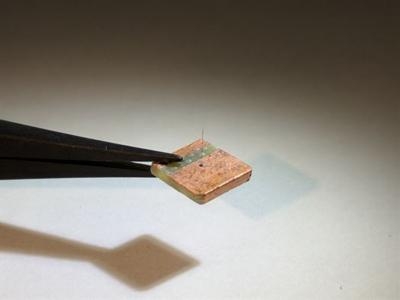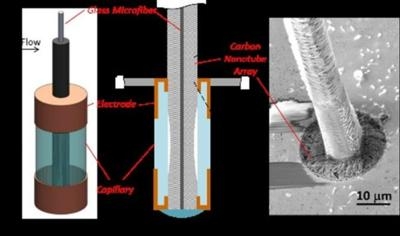Carbon Nanotubes May One Day Allow Aircraft To 'Fly By Feel'
Nature has inspired scientific and engineering innovations for hundreds of years. An apple falling from a tree inspired Isaac Newton to define the laws of gravity. The burdock burrs clinging to the skin of his hunting dog lead to Swiss engineer Georges de Mestral’s invention of Velcro. The ability of the kingfisher to slice through water to catch prey inspired the redesign of the high-speed Japanese bullet train, enabling it to exit tunnels quietly at a speed ten percent faster than predecessors.

For scientists at the Air Force Research Laboratory, it is the hairs on bats and crickets that inspired the creation of artificial hair sensors, destined to change the course of agile flight.
“Ever notice how a cricket might stop chirping when you walk into a room? It’s because it detects a big air disturbance and does not know if you are a friend or a foe,” said Dr. Jeff Baur, a principal engineer in the structural materials division, materials and manufacturing directorate. “Nature has given bats and crickets these fine hairs that they use to sense changes in their environment. We hypothesized that if we could engineer similar hairs at the surface of an aircraft, we could enable an agile flight system that can detect air changes and ‘fly by feel.’”
Thus, a multi-directorate artificial hair sensor team funded by the Air Force Office of Scientific Research was started to develop an innovative, adaptive, multifunctional structure for Air Force systems. Beginning in the lab as a ‘proof of concept’ experiment, the artificial hair sensors have gained international interest, with aerospace companies and researchers eager to integrate these into their wind tunnel models and flying systems.
Moreover, the research has also resulted in three patent applications based on the research activity —a highlight for scientific research in any field.
“We’re providing new insights and non-traditional outlets for long-term (AFRL) research. The project has moved to the point where we are making these sensors, evaluating them in the wind tunnel within AFRL and distributing them to collaborators across the globe to try them out in different concepts. It’s exciting,” Baur said.
For the Air Force, the need to understand ambient air data and its effects on aircraft performance, navigation and more has become more critical as flying machines are now lighter and operate in diverse environments. The need for ‘fly-by-feel’ systems, where aerial systems have distributed smart sensors to assess the external environment and change maneuvers during the course of flight, is increasingly important as agile fliers join the fleet.
Conventional aerial systems typically draw data from bulky “bolted-on” sensors, resulting in single point measurements with delayed sensing. The Artificial Hair Sensor team created a novel, lightweight artificial hair sensor that mimics those used by natural fliers—like bats and crickets—using carbon nanotube forests grown inside glass fiber capillaries. The hairs are sensitive to air flow changes during flight, enabling quick response by fliers.

Carbon nanotubes, revered by material scientists for having a high strength-to-weight ratio as well as their ability to conduct electrically, form the basis for these hair sensors and are grown inside of a glass capillary with electrodes on each end. With a diameter of less than one-tenth of a human hair, the sensors work when air flows over the fiber, compressing the carbon nanotube, causing a change in the resistance between the electrodes. This information is analyzed by a “brain-like” neural network, in which an algorithm is able to process and dictate a response. “These can help to better understand aerodynamics or wind gusts in an urban environment, for example. Imagine my agile aircraft is turning the corner of a building — the wind may change. If I have a system that can detect a gust is coming, I can adjust immediately to stay on course,” said Dr. Greg Reich, a team member from the Aerospace Systems Directorate.
Though a large portion of development and bench-level lab testing of the sensors took place here, the team took advantage of pressure wave tubes developed at the Munitions Directorate by Dr. Ben Dickinson and wind tunnels within the Aerospace Systems Directorate to validate the sensor durability and sensitivity to speed. “By changing the diameter of the capillary, we are able to detect different wind speeds and have shown success at up to 100 miles per hour,” Baur said. “We are still in the process of evaluating durability, but already we have tested the same sensor for more than 316 hours. This shows great promise.”
Another potential application for the artificial hair sensors, according to Baur, is in bonded composites. By applying the sensors across bonded material, researchers can internally detect what is going on inside of a bond, which may allow them to detect a break before it happens.
Ultimately, the artificial hair sensors are just one way the scientists and researchers at AFRL continue to advance technology and the state-of-the-art for Air Force systems of now and the future. “We’re just working to understand how nature does things and taking advantage of this understanding and knowledge for the Air Force,” Baur said.
(Image provided with USAF news release)
 Senator Pushes FAA to Accelerate Rocket Launch Licensing
Senator Pushes FAA to Accelerate Rocket Launch Licensing Classic Aero-TV: RJ Gritter - Part of Aviations Bright New Future
Classic Aero-TV: RJ Gritter - Part of Aviations Bright New Future Aero-FAQ: Dave Juwel's Aviation Marketing Stories -- ITBOA BNITBOB
Aero-FAQ: Dave Juwel's Aviation Marketing Stories -- ITBOA BNITBOB ANN's Daily Aero-Linx (10.27.24)
ANN's Daily Aero-Linx (10.27.24) ANN's Daily Aero-Term (10.27.24): Clearance Void If Not Off By (Time)
ANN's Daily Aero-Term (10.27.24): Clearance Void If Not Off By (Time)




